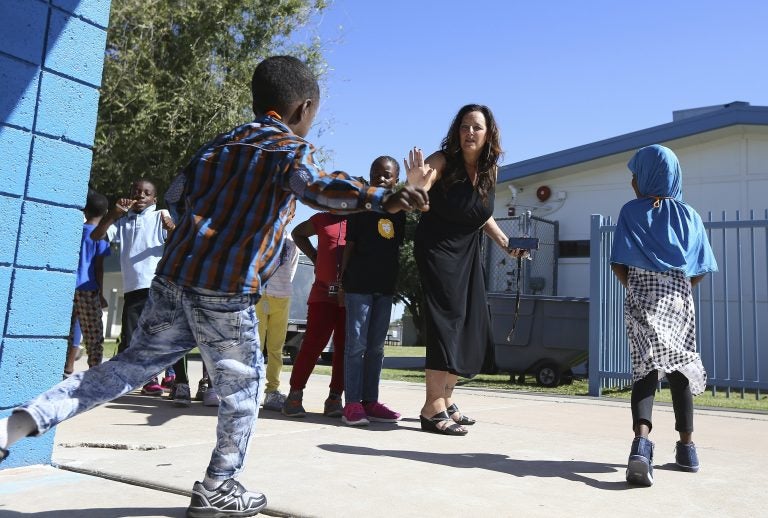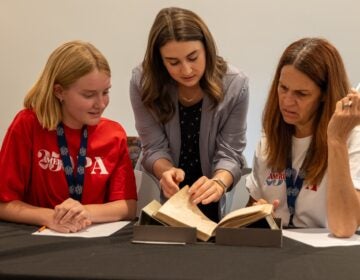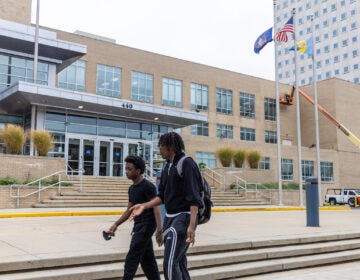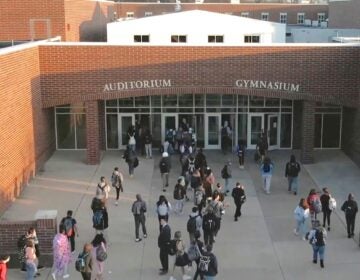Schools teach refugee, migrant kids skills to succeed in U.S.
International flags flutter at Valencia Newcomer School, where more than 200 children from around the world are learning English skills and American classroom customs.

Director Lynette Faulkner, middle, tries to slow down a student at Valencia Newcomer School between classes, in Phoenix. (Ross D. Franklin/AP Photo)
International flags flutter from the ceilings of the outdoor hallways at Valencia Newcomer School, where more than 200 children from around the world are learning English skills and American classroom customs they need to succeed.
When the school year begins, the refugee and immigrant children often don’t know the rules. A kid might be fascinated with a light switch they excitedly turn off and on. Another is startled by a whistle or a helicopter buzzing overhead that recalls conflict back home.
But fears melt away as the kids adjust, said Valencia Principal Lynette Faulkner, who calls the school their “safe place.” Soon, they stand in line, raise their hand, keep their feet on floor. As they learn English, students make friends across cultures.
Since fall 2018, the public school has welcomed students from countries including Myanmar, Eritrea, Indonesia, Afghanistan and Cuba for an extra year of attention before transferring to mainstream schools. This year’s kindergarten through eighth-grade students come from 21 countries and speak 15 languages.
Valencia is among a handful of U.S. public schools dedicated to helping some of the thousands of children who arrive in the country each year, even as the Trump administration has proposed pushing down the annual cap for refugees to a historic low of 18,000. No refugees were settled in the U.S. last month.
The schools aren’t necessarily in cities with more refugees, but where local education officials took the initiative to create them. Similar schools are in Indianapolis; Houston; Fort Worth, Texas; Greensboro, North Carolina; and Providence, Rhode Island.
Arizona ranks eighth among states for refugee resettlement. The number plunged from 4,110 people in fiscal year 2016 to 998 in 2018, then rose slightly to 1,216 for the 12-month period that ended Sept. 30. About half are kids.
Gov. Doug Ducey hasn’t weighed in yet on President Donald Trump’s executive order allowing states and cities to reject refugees. At least five states have signaled they will accept refugees, and no governor has said they plan to keep them out. Several agencies sued last week seeking to halt the order.
“There may be less, but they’re still coming,” Valencia teacher Kristine Jones said. “And we have to be there for them, whether it’s academically or getting them services like immunizations.”
It’s unclear if the lower cap on refugees will affect already limited funding for school districts from the Office of Refugee Resettlement’s Refugee School Impact Program.
The Arizona Department of Economic Security last year distributed about $635,000 to help 1,026 school-age refugees statewide with things like interpretation, tutoring and school supplies.
Immigrants and other children newly arrived from abroad can attend newcomer schools if they need help with basic English, including those born in the U.S., taken out of the country and returned.
“As long as you have kids struggling with English, there will always be a place for these kinds of programs,” said Deborah Short, a Washington-based English learning specialist who has written about newcomer education. She noted some mainstream schools have newcomer classrooms.
Rebecca Kawa, 10, didn’t learn English at the refugee camp in Uganda where she was born and spent most of her life, studying in a classroom with up to 200 students. But she needed no interpreter after only two months at Valencia.
“I like this school because they teach you English, and you learn it fast,” said the daughter of Congolese refugees.
There are often huge challenges for children who trudged across several countries, lived in camps or witnessed extreme violence.
Refugee and other immigrant children who lose a home or parent can suffer from toxic stress, a term used by child development experts for the body’s response to long-term adversity, said Sarah Smith, senior director of education for the nonprofit International Rescue Committee.
“Infants might cry for long periods of time,” Smith said. “Children in school might have a hard time concentrating.”
Newcomer school teachers and social workers strive to ensure children get the social and emotional time they need to talk through feelings and make new friends. Valencia social worker Michelle Frias said that over the last year, she’s referred about 10 kids to psychologists for extra care.
At Valencia, the day starts with teachers greeting students as they step off the buses. Samuel Lavi, a teaching assistant from Congo who speaks seven languages, is the first to give each kid a hug or high-five.
“My most important role is to make sure the students get what they’re supposed to get,” he said.
Inside the classrooms, brightly colored letters adorn the walls. Small groups of children face each other at round tables as they listen to an instructor trained to teach English to non-native speakers. They also have math, art, music and physical education.
Outside, kindergartners with plastic jugs water the flower and vegetable gardens built with materials donated by the Arizona Cardinals football team. The Diamondbacks baseball club paid to spruce up the school before it opened and donated trees.
Faulkner, the Valencia principal, said the Alhambra School District looked into newcomer programs after seeing new arrivals struggle to meet state English language standards. She visited Las Americas newcomer school in Houston.
Las Americas has some 400 students in fourth through eighth grades who come from up to 32 countries and speak 29 languages, Principal Marie Moreno said.
“We wanted to provide them a space where they can get grounded, whenever they feel traumatized or whenever they remember something from the past,” Moreno said as she showed off the school’s “peace garden.”
“We try to support them by helping them understand where they came from and where we want them to go,” she said.
WHYY is your source for fact-based, in-depth journalism and information. As a nonprofit organization, we rely on financial support from readers like you. Please give today.




